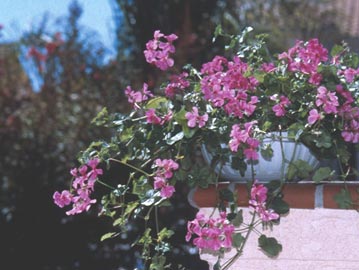Ground-breaking flowers breathe new life into Grandma’s old favorite
If you’re tired of the same old sparsely blooming red geraniums and haven’t had much luck with the sleeker ivy geraniums either, there’s a new kid on the block. Flower breeders have come up with a new line of geraniums that takes the best traits – and eliminates the flaws – of two age-old types. The effort combines the heat tolerance and durability of common zonal geraniums with the good looks and heavier bloom of ivy geraniums to come up with a new type known as an “interspecific geranium.” Interspecific means the result is a cross of two different species in the same family or “genus.”
 One of the best new interspecific geraniums is this one, called Calliope™ Dark Red.
One of the best new interspecific geraniums is this one, called Calliope™ Dark Red.
You’ll find these new geraniums in garden centers under such names as Caliente®, Calliope™, Galleria™, ‘Double Take,’ ‘Salsarita,’ ‘Cumbanita,’ ‘Dixieland,’ Boldly™ and Timeless™. Those and others in the pipeline are breathing new life into a type of annual flower that’s been an American favorite since the early 1800s.
 Zonal geraniums are one of the two parents of interspecific geraniums and get their name from the dark halo in the green leaves.
Zonal geraniums are one of the two parents of interspecific geraniums and get their name from the dark halo in the green leaves.
© National Garden Bureau
Most common is the zonal geranium, so called because of the burgundy halo (“zones”) found in the rounded, crinkled, green leaves. These are the geraniums that are used (some would say over-used) in pots everywhere, usually with a dracaena spike in the middle and variegated vinca trailing down the edge. Zonal geraniums send up flower stems above the foliage that produce umbrella-like clusters of red, pink, rose, white or salmon. Their big attractions are that they do well in heat and humidity, tolerate dryness better than most annual flowers and are easy to store over winter for subsequent seasons. In other words, they don’t give up easily. For that, gardeners are willing to put up with two main flaws: 1.) blooms that aren’t as showy and prolific as most other modern annual flowers, and 2.) the constant need for neatening snips as those stem-top flowers keep maturing from red or pink to brown.
Ivy geraniums are generally more attractive options with their trailing habit, glossy leaves and heavier and longer-lasting blooms. Their main drawback, however, is that have the bad habit of melting away in summer heat. That makes them a poor choice in the South and Southwest as well as even much of the mid-Atlantic and Midwest.
 The other interspecific geranium parent is the ivy geranium, a more trailing plant with glossy leaves.
The other interspecific geranium parent is the ivy geranium, a more trailing plant with glossy leaves.
© National Garden Bureau
The new best-of-both-worlds interspecific geraniums open the door to all sorts of new variations – especially new colors, glossy leaves and better blooms in hot-summer areas. Most of the interspecifics have growth habits that are mounded to semi-trailing. They’re good choices for pots and hanging baskets in addition to in-ground plantings. Interspecifics also clean themselves better than zonal types, although they still look their best and bloom best when spent flowers are “deadheaded.”
As with all geraniums, interspecifics perform best in loose, rich, well drained soil that’s kept consistently damp but never soggy. Geraniums also appreciate adequate nutrition, either liquid flower fertilizer every 2 to 4 weeks or monthly applications of a long-acting fertilizer. Interspecifics will grow in full sun or part shade.